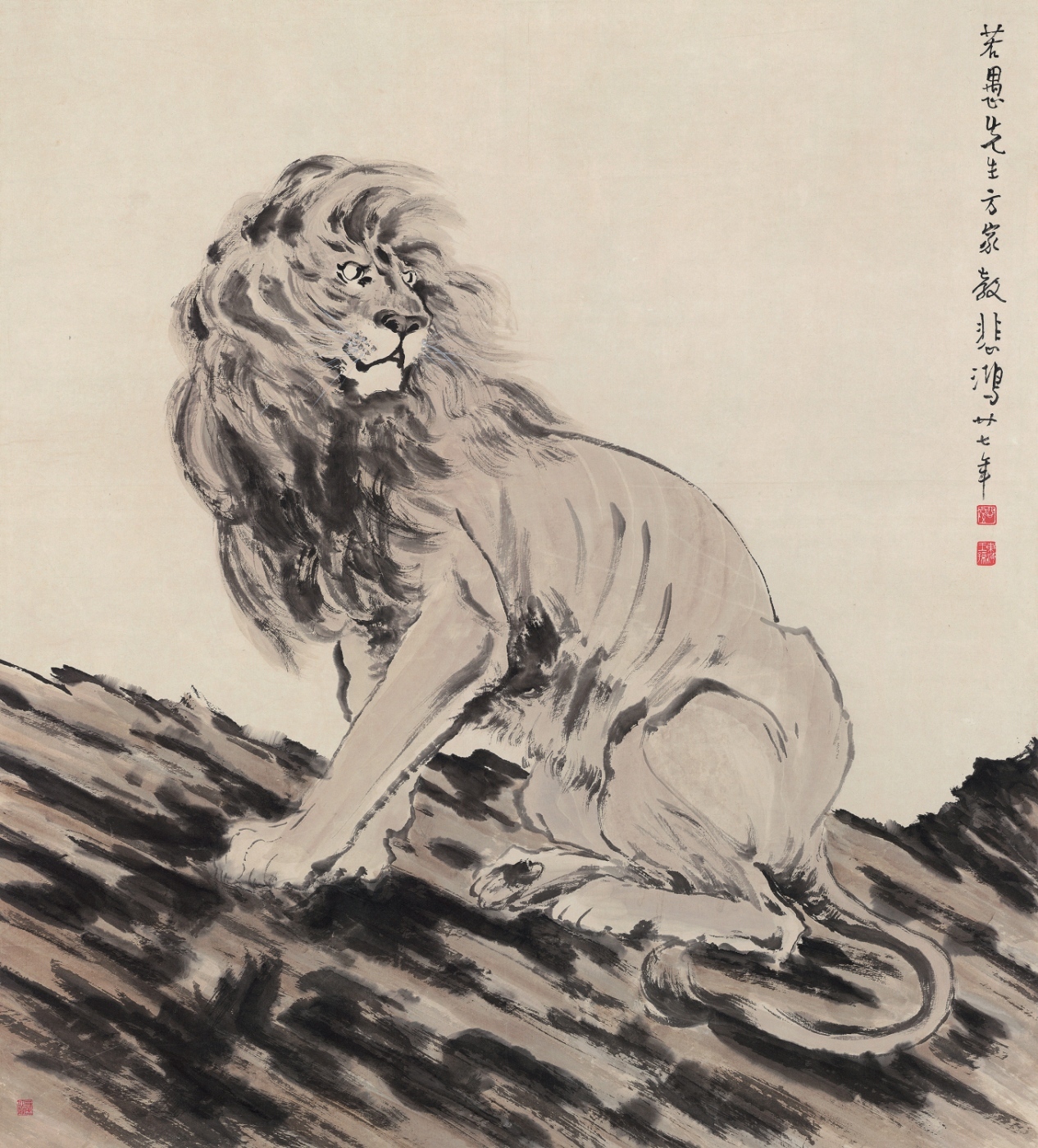徐悲鴻
BEI HONG XU

徐悲鴻(1895年7月19日—1953年9月26日),原名徐壽康,男,江蘇宜興人,中國現代畫家、美術教育家,兼擅油畫及水墨畫。中國現代美術的奠基者,與顏文樑、林風眠和劉海粟並稱「四大校長」,著名學生有艾中信、吳作人等。
BEI HONG XU (July 19, 1895 – September 26, 1953), originally known as SHOU KANG XU was a distinguished male artist and art educator hailing from Yixing, Jiangsu, China. Proficient in both oil painting and traditional Chinese ink wash painting, he is recognized as one of the pioneering figures in modern Chinese art. Often referred to as one of the "Four Great Deans" alongside WEN LIANG YAN, FENG MING LIN , and HAI SU LIU, BEI HONG XU's notable students include ZHON XIN AI and ZUO REN WU.
簡介
徐悲鴻是江蘇宜興屺亭鎮人。自幼隨父徐達章習詩文書畫,1912年在宜興師繪畫。1916年入復旦大學法文系半工半讀,1917年留學日本學習美術。回國後任北京大學畫法研究會導師。
1919年赴法國留學,1923年入巴黎國立美術學校,學習油畫、素描,並遊歷西歐諸國觀摹研究西方美術。1927年回國,先後任上海南國藝術學院美術系主任、北京大學藝術學院院長。1929年移居南京,於國立中央大學任教。
1933年起在世界各地舉辦中國美術展覽和個人畫展。此後重返南京,擔任中央大學藝術系教授兼系主任。1946年任國立北平藝術專科學校校長,1950年任中央美術學院院長。曾任中華全國美術工作者協會主席。徐悲鴻對中國後現代藝術的深遠影響和對藝術教育的不朽貢獻,一直為後人所敬仰。
Biography
Born in Qiting Town, Yixing, Jiangsu, BEI HONG XU began his artistic journey under the guidance of his father, DA ZHANG XU, exploring poetry, literature, calligraphy, and painting from a young age. In 1912, he commenced formal painting studies at a local art school in Yixing. Enrolling in the French Language Department at Fudan University in 1916, he adeptly balanced work and study. A year later, he ventured to Japan for artistic studies, subsequently returning to China to contribute as a mentor at the Painting Research Society of Peking University.
The year 1919 marked BEI HONG XU's journey to France for further artistic exploration. Enrolling in the National School of Fine Arts in Paris in 1923, he delved into the realms of oil painting and sketching. Immersing himself in Western European countries, he absorbed insights into Western art. Returning to China in 1927, he held significant positions such as the head of the Art Department at the Shanghai National College of Art and later as the Dean of the School of Art at Peking University. Relocating to Nanjing in 1929, he continued his teaching career at National Central University.
From 1933 onwards, BEI HONG XU played a pivotal role in organizing and participating in Chinese art exhibitions worldwide. Upon his return to Nanjing, he served as a professor and department head at the School of Art at National Central University. In 1946, he assumed the presidency of the National Beiping Academy of Art, and in 1950, he took on the role of president at the Central Academy of Fine Arts. Concurrently, he held the esteemed position of chairman of the Chinese Artists Association.
BEI HONG XU's profound impact on modern Chinese art and his enduring contributions to art education continue to be revered by subsequent generations.

徐悲鴻 《 雄獅圖 》 鏡心 設色紙本
103 x 93 cm, 1938
題識:若愚先生方家教,悲鴻廿七年。鈐印:「悲鴻」、「東海王孫」
說明:上款「若愚先生」指吳道安,時任國民政府的廣西壯族自治區副主席、國民參政會參政員貴州委員。
徐悲鴻畫馬最為聞名,但不代表他只會畫馬。他完美掌握了動物的肌理、神情、姿態,故此他筆下的飛禽與走獸,全都活靈活現。此幅《雄獅圖》中,畫家精確地捕捉到瘦骨嶙峋的獅子神態,用乾筆擦染出鬣毛,似隨風飄揚,充滿動感。
除了展現獅子的動感,此作還有另一重深意。
《雄獅圖》作於1938年,畫面中一頭雄獅踞坐於嶙峋險峻的山石上,回首目眺遠方,眼神堅定,身形骨瘦如柴,卻絲毫不減剛毅風神。雄獅長鬣迎風拂動,似是身處風雨欲來的環境中,但勇者無畏,盡現氣概。
同年初,徐悲鴻完成他的動物題材代表作《負傷之獅》(現藏於徐悲鴻紀念館),尺幅與此作相當,獅子體型與山石角度略有調整,應是徐氏於國難中托物言志之作,象徵頑強抵抗的意志。
上款「若愚先生」指吳道安,時任國民政府的廣西壯族自治區副主席、國民參政會參政員貴州委員。吳道安在廣西、貴州等地為徐悲鴻舉辦展覽,後者為答謝吳氏的關照與支持,畫了這幅精品贈送給他。
While BEI HONG XUis most celebrated for his depictions of horses, it's important to note that his artistic prowess extended far beyond equine subjects. He demonstrated a remarkable mastery of the musculature, expressions, and postures of various animals, infusing vitality into both winged and terrestrial creatures within his oeuvre. In the case of "Majestic Lion," the artist adeptly captures the regal essence of a lean and sinewy lion. Employing precise dry brush techniques, he skillfully renders the lion's mane, imbuing the artwork with a sense of dynamism as if it were gently swaying in the wind.
Beneath the surface of this captivating portrayal of a lion lies a deeper layer of meaning.
Executed in 1938, the composition features a male lion seated on rugged and precipitous rocks, casting a determined gaze toward the distance. Despite the lion's lean physique, it emanates an unwavering strength and resolve. The flowing mane, depicted with a deft touch, appears to flutter in the wind, suggesting an environment fraught with impending challenges. Nevertheless, the courageous lion remains resolute, symbolizing indomitable spirit.
In the early months of the same year, BEI HONG XU completed another significant animal-themed masterpiece, "Wounded Lion" (currently housed in the BEI HONG XUMemorial Hall). Comparable in size and featuring a lion with similar anatomy, albeit with a slight adjustment in the angle of the rocks, this work is believed to express BEI HONG XU's defiance and resilience in the face of the adversities of war.
The inscription "Ruo Yu Xiansheng" refers to DAO AN WU, who at the time served as the Vice Chairman of the Guangxi Zhuang Autonomous Region and was a member of the National Political Consultative Conference in Guizhou. DAO AN WU played a pivotal role in organizing exhibitions for BEI HONG XU in Guangxi and Guizhou. In gratitude for WU's support, BEI HONG XU presented him with this exquisite piece.
徐悲鴻 《 墨竹 》 鏡心 水墨紙本
90 x 30.5 cm, 1942
題識:參天將焉用,廣被復無能。四顧安所託,真成孤竹君。壬午夏畫,悲鴻。鈐印:「東海王孫」、「悲」

